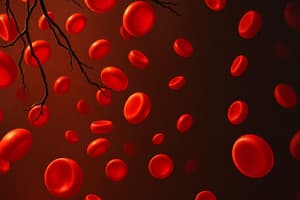Podcast
Questions and Answers
What is the primary function of the globin component of hemoglobin?
What is the primary function of the globin component of hemoglobin?
What is the process called when the spleen and liver remove old or damaged red blood cells from circulation?
What is the process called when the spleen and liver remove old or damaged red blood cells from circulation?
What is the name of the genetic disorder that affects hemoglobin production, leading to anemia and other complications?
What is the name of the genetic disorder that affects hemoglobin production, leading to anemia and other complications?
What is the shape of a red blood cell?
What is the shape of a red blood cell?
Signup and view all the answers
What is the approximate lifespan of a red blood cell in circulation?
What is the approximate lifespan of a red blood cell in circulation?
Signup and view all the answers
What is the function of red blood cells in terms of pH regulation?
What is the function of red blood cells in terms of pH regulation?
Signup and view all the answers
Study Notes
Structure and Function
- Biconcave disk shape, flexible, and disk-shaped to increase surface area
- No nucleus, allowing for more hemoglobin and increasing oxygen-carrying capacity
- Cell membrane composed of lipids and proteins, providing flexibility and structure
Components
- Hemoglobin (Hb): protein that binds to oxygen, giving RBCs their red color
- Heme: iron-containing group within hemoglobin that binds to oxygen
- Globin: protein component of hemoglobin that helps stabilize the heme group
Formation and Lifespan
- Produced in bone marrow through erythropoiesis
- Lifespan: approximately 120 days in circulation
- Removed from circulation by spleen and liver through a process called eryptosis
Functions
- Oxygen transport: carries oxygen from lungs to body tissues
- Carbon dioxide transport: carries carbon dioxide from body tissues to lungs
- Buffering: helps regulate blood pH by buffering excess hydrogen ions
Abnormalities and Diseases
- Anemia: insufficient RBCs or hemoglobin, leading to inadequate oxygen delivery
- Sickle cell anemia: genetic disorder causing abnormal hemoglobin, leading to RBC deformation and premature destruction
- Thalassemia: genetic disorder affecting hemoglobin production, leading to anemia and other complications
Structure and Function of Red Blood Cells
- Red blood cells have a biconcave disk shape, which increases their surface area and allows for flexibility.
- The absence of a nucleus in red blood cells enables them to carry more hemoglobin and increase oxygen-carrying capacity.
- The cell membrane of red blood cells is composed of lipids and proteins, providing flexibility and structure.
Components of Hemoglobin
- Hemoglobin is a protein that binds to oxygen, giving red blood cells their red color.
- Heme is an iron-containing group within hemoglobin that binds to oxygen.
- Globin is a protein component of hemoglobin that helps stabilize the heme group.
Formation and Lifespan of Red Blood Cells
- Red blood cells are produced in bone marrow through a process called erythropoiesis.
- Red blood cells have a lifespan of approximately 120 days in circulation.
- The spleen and liver remove red blood cells from circulation through a process called eryptosis.
Functions of Red Blood Cells
- Red blood cells transport oxygen from the lungs to body tissues.
- Red blood cells transport carbon dioxide from body tissues to the lungs.
- Red blood cells help regulate blood pH by buffering excess hydrogen ions.
Abnormalities and Diseases of Red Blood Cells
- Anemia is a condition where there are insufficient red blood cells or hemoglobin, leading to inadequate oxygen delivery.
- Sickle cell anemia is a genetic disorder that causes abnormal hemoglobin, leading to red blood cell deformation and premature destruction.
- Thalassemia is a genetic disorder that affects hemoglobin production, leading to anemia and other complications.
Studying That Suits You
Use AI to generate personalized quizzes and flashcards to suit your learning preferences.
Description
Learn about the biconcave disk shape, flexible structure, and components of red blood cells, including hemoglobin and its roles in oxygen-carrying capacity.




